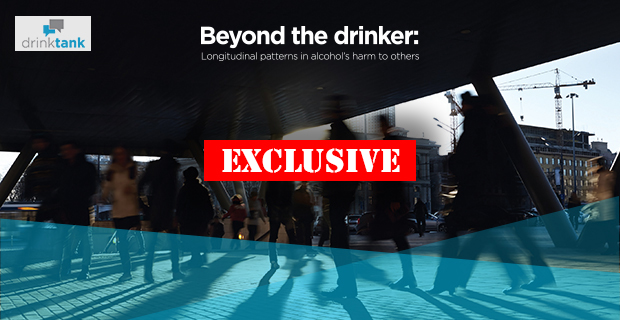A new study has revealed that almost two thirds of people identified as being harmed by the drinking of others in a 2008 survey, were still being harmed three years later.
And it’s not your age, gender or the number of times that you go out that is most likely to determine whether you are at risk of being harmed, but rather the number of heavy drinkers in your life.
The study, Beyond the drinker: Longitudinal patterns in alcohol’s harms to others, followed up Australian adults first surveyed in 2008 to see what level of harm they were experiencing as a result of other people’s drinking; whether this situation was remaining stable, improving or worsening; and what factors might predict patterns over time.
The study found that having been harmed in 2008 was a strong predictor of harms in 2011, with 65 per cent of people who were negatively affected in 2008 reporting that they are still being harmed by the drinking of others.
Funded by the Foundation for Alcohol Research and Education (FARE) and undertaken by the Centre for Alcohol Policy Research (CAPR) the study expands on the landmark research from Australia’s first Harm to Others population survey, The range and magnitude of alcohol’s harm to others, published in 2010.
CAPR Director Professor Robin Room says the longitudinal data presented a unique opportunity to examine how individual experiences of alcohol’s harm to others persist or change over time.
“We wanted to see whether people harmed by the drinking of others three years ago are still being harmed, and to better understand the determining factors. This study clearly demonstrates the persistent and ongoing nature of alcohol’s harm to others,” Professor Room said.
The findings showed that the majority of Australians (62 per cent) have been harmed as a result of someone else’s drinking in at least one of the two surveys. Almost one third (32 per cent) were negatively affected in both years.
The research also highlighted the influence of social circles; with the number of heavy drinkers in a person’s household, including close relatives and intimate partners, being a strong predictor of experiencing alcohol-related harm from others. This was more significant than other variables examined, including the demographics and drinking habits of the person who was being harmed.
Alarmingly, with each additional heavy drinker in their household this risk intensified, with respondents almost six times more likely to experience harm.
FARE Chief Executive Michael Thorn says that the findings are an important reminder for governments of the negative effects of alcohol consumption and the collateral damage alcohol frequently causes to women and children.
“This research highlights the scale and the persistence of alcohol harms that extend beyond the drinker and makes clear that, in order to address and reduce alcohol’s harm to others, Australia needs comprehensive measures such as those that impact on the price, availability and advertising of alcohol in order to diminish the prevalence of heavy drinking in the overall population,” Mr Thorn said.
Key findings
- In 2008 the first comprehensive study of the harms from alcohol experienced by people other than the drinker was undertaken in Australia.
- In 2011, 1,106 people involved in the original study were re-contacted to participate in a repeat survey to determine the stability and change in harm from others’ drinking over time.
- Sixty-two per cent of respondents had experienced harm from others’ drinking in at least one or both surveys.
- Personal experience of harm (or lack of harm) did not change for the majority (70 per cent) of respondents between 2008 and 2011, with almost a third of respondents harmed by others’ drinking in both years (32 per cent) and 38 per cent not harmed in either year.
- Past experience of harm was a strong predictor of harm, with 65 per cent of respondents experiencing harm in 2008 reporting this again in 2011.
- The number of heavy drinkers in respondents’ households and among other relatives and intimate partners in 2008 was a strong predictor of respondents’ experience of alcohol-related harm in 2011.
- For each additional heavy drinker within their households, respondents were almost six times more likely to experience persistent harm from known problematic drinkers in their lives.
- To reduce the significant social problem of alcohol’s harm to others, policy responses at community, state and national levels are needed to diminish the prevalence of heavy drinking in the population.








Add comment